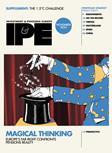Research is an area that always comes under heavy scrutiny when money managers are under pressure. Managers with their backs to the wall want to know how much value research is really adding to their investment processes.
They will want to know how useful is the information that analysts provide to equity managers to support their decisions about what to buy, sell or hold. They will also want to know what value to place on different approaches to research, whether this is a ‘number crunching' quantitative approach, or an ‘eyes wide open' qualitative approach.
One way of answering these questions is to push the analysts to the front of the stage so that the audience can see how they perform. Analysts are typically the back room boys of the investment process, feeding information through to portfolio managers, but rarely having to take direct responsibility for their
decisions.
Jim Goff, director of research at Janus Capital, believes that analyst-driven investment is the way forward. Analysts should not only have the courage of their convictions, but should have a chance to prove it.
"We live in one of the most measurable businesses in the world, but a lot of heads of research don't often measure the value of their research. The question we should ask is ‘does the research add value?' If it doesn't add value, then it doesn't much matter how you put that research together. You're just putting lipstick on a pig."
So when Goff took over as head of research at Janus in 2002 he asked analysts to rate their stocks, sell, neutral, buy and strong buy.
"It was not a novel concept, and people have done it before. But part of what I was trying to do was measure the individual analyst, and whether they were adding value relative to their coverage, and to factor this into their compensation.
"We wanted to know whether they were adding value in isolation. We also looked at whether they were adding value in the portfolios."
Goff then looked at the performance according to sectors. "We wanted to know how we would do in a simulated portfolio if we owned an equal weighted portfolio of all our buys and strong buys, whether in consumer staples, techs or financials, relative to the broader market
The results showed that between early 2002 and mid 2004, the buys significantly outperformed the broader market in every sector. "By studying the analysts in isolation we could see that they were adding value."
Since analysts were adding value across all sectors, there was a strong case for creating sector-neutral portfolios, he says.
Goff also wanted to look at stocks and stock picking from an analyst's rather than a portfolio manager's perspective. "We needed to move away from a portfolio manager-led way of doing things where portfolio managers concentrate on certain holdings, and overweight certain sectors and impart their particular discipline or style on that
portfolio."
The aim was to produce a pool of ‘best ideas' rather than rely on individual portfolio managers' hunches, he says. "Because you are sourcing ideas from 37 analysts you are going to get a lot of ‘best ideas'. The process is going to be more diversified, sector neutral and team-driven."
How the research is handled is also important, says Goff. He distinguishes two approaches to analyst-driven investment. "One is the silo approach where a single analyst covers 3% of the index and you get 3% of the portfolio and you manage it however you want to. The other is a consensus approach where a team votes on the ideas."
One solution is to combine the individual and team approach, says Goff. "Looking back at what inspired us to create these portfolios, at our picks within sectors and the buys, it is clear that teams had nothing to do with those individual analysts' ratings. It was all down to the individual analysts, so it's important not to lose that."
Janus Capital has developed a hybrid investment process which Goff describes as "analyst-driven and team-refined". This enables analysts to feed their own ideas into a portfolio up to a certain size of position. Above that, they have to get the agreement of the rest of the team.
"This allows people to get non-consensus ideas in the portfolio and it helps you avoid that group-think that can flush out your original value added," says Goff.
The process operates a simple weighting system of full weight and medium weight. Weighting varies according to each team's portfolio. A full weight in the industrials team, for example, would be 2% and a medium weight would be a 1%.
"For an idea to get into the portfolio it has to be recommended for inclusion and rated a buy or strong buy by the covering analyst. That factors into their compensation," says Goff.
"Each analyst is allowed to introduce two or three stocks into the portfolio at a medium position. But if the analyst wants a stock at the top of the portfolio they've got to get buy-in from their peers.
"So before any stock goes in, it has to be debated by the team. And if you want that stock to be at a full weight then the team has to approve that."
Analyst-driven research also makes use of second opinions that are entirely uncorrelated with the portfolio managers' stock picking. In the late 1980s, RCM, now an asset management arm of Allianz Global Investors, created Grassroots Research, a network of researchers whose job was to uncover and investigate market place trends.
The researchers were there to provide a ‘reality check' for RCM portfolio managers' investment decisions, bridging - as RCM puts it - the information gap between Main Street and Wall Street.
Grassroots Research grew out of the Atari debacle, when the video games producer, with an 80% market share of video games, bought the video game rights of ET, the biggest movie of 1982, The ET video game flopped and Atari posted a $536m loss in 1983.
Gunnar Miller, co-head of global research for RCM, says the collapse of Atari was a wake up call. "RCM fund managers in San Francisco told us they had their kids home from university, sitting around for two weeks doing nothing, when they could have sent them around some of the shops. The kids could have come back and told us that maybe something was rotten in the state of Denmark."
RCM puts Chinese walls between Grassroots researchers and portfolio managers, Miller says. "The way it's set up as a dotted line, third-party separate legal entity means that we don't want the investigative journalists to have any idea of what our position is.
"We want to avoid the ‘shoot the messenger' syndrome, where a portfolio manager says to an investigative journalist: ‘Since we own 13% of this and we're up 50% why don't you go out right now and fish round and find anything that might take us out.'"
Reporters should take a step back from the portfolio managers and analysts, he says. "Grassroots can only do two things. It either underscores your conviction or it results in a lessening of that conviction."
Grassroots research also shows that sometimes good news is bad news, says Miller. "A company may be selling a product really well because they've discounted heavily in everything. But when you map that across to the financial modelling you discover that what they are picking up in volume they are losing in margin."
Investigative reporters are doing the job that portfolio managers and analysts cannot afford the time to do, he says. " I don't want highly trained financial professionals like portfolio managers and analysts going out and playing amateur detectives. Sending investment managers out to do that same kind of shoe leather journalism is counter productive."
Miller counters criticism that such research is unscientific by suggesting that most scientific research produces more data than is necessary for investment decision-making.
"Hiring someone for a year-long cross-sectional million euro analysis is overkill. First, it's not actionable, and second, by the time you've assembled all that data using heavy statistical methods you've probably lost the opportunity you were looking for anyway.
"It's like portfolio diversification. Once you get to 18 to 20 responses and you are starting to get consistent answers you are probably in pretty good shape. You don't have to take it to 250 responses to make it actionable. You could, but then you'd lose your time advantage."
One advantage of this approach is that it is intuitive, and can recognise that the wrong answers are often a result of the wrong questions, says Miller. "The best part of this design is that if they realise a study is not getting the results we need they can jam the brakes on and redesign it in a couple of days," he says.
"There is the ability to fine tune the model rather than getting a million dollar bill from a management consultancy firm." In this situation, analyst-driven research demonstrably adds value.












No comments yet